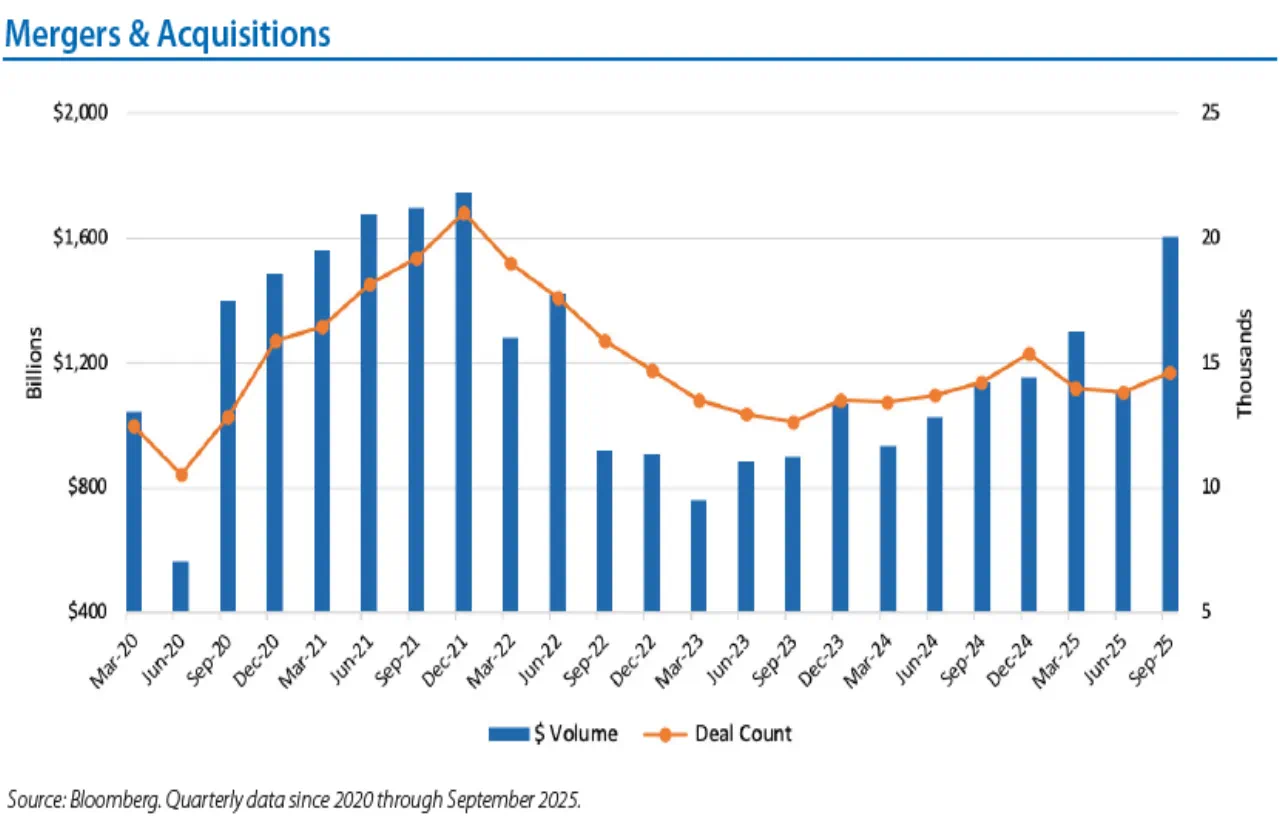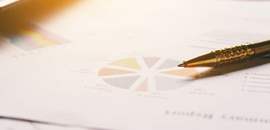Asset Allocation Chart of the Month
Potential Tailwinds for Risk Assets
- Fiscal Stimulus Reawakens Growth. The OBBBA (One Big Beautiful Bill Act) is set to inject stimulus into the economy. Tax changes should lift consumer refunds and spending, while new tax incentives for business investment and construction should spur capital expenditures, augmenting already announced spending increases for data center buildout. The OBBBA is estimated to add 0.2-0.5 percentage points to real GDP in 2026. In addition, the Trump administration has begun to address affordability concerns by rolling back select tariffs and may take further steps to support lower-income consumers ahead of the mid-term elections.
- Deregulation. According to Jefferies, looser bank regulation could unlock as much as $2.6 trillion in lending capacity. M&A activity and IPO issuance are already rebounding, and greater lending capacity could accelerate these trends in 2026. Sentiment among global investment banks is improving, aided by reduced economic risk, expectations for lighter regulation, and the return of deal profitability – all reinforcing a more optimistic outlook for capital markets.
- Monetary Tailwinds. Financial conditions have eased considerably and are likely to remain supportive. M2 growth has turned positive, trending up roughly 4% year-over-year, signaling renewed liquidity. The Federal Reserve (Fed) is winding down its quantitative tightening program and is expected to continue lowering rates into 2026. While we believe inflation will remain sticky, productivity gains could usher in a disinflationary environment, giving the Fed room to ease more than markets currently anticipate.
- Productivity Gains. 2026 may be the year when AI applications begin delivering measurable productivity improvements. Companies that integrate AI-driven automation, workflow optimization, and other methods may see margin expansion and drive higher-than-expected profits.
- Growth Spillover. Beyond Mega-Caps. Market leadership may broaden as liquidity and earnings momentum extend to Value stocks and small- and mid-cap companies. These segments lagged for several years but could benefit from renewed economic growth and from the use of AI applications.
- International Keeps Going. A potential resolution to the war in Ukraine would remove a major overhang on energy prices and investor sentiment. The subsequent rebuilding effort could stimulate European growth, while lower energy prices could help lower European manufacturing costs. Meanwhile, Fed rate cuts and additional Chinese stimulus could support emerging markets, extending the global recovery into 2026.

The Touchstone Asset Allocation Committee
The Touchstone Asset Allocation Committee (TAAC) consisting of Crit Thomas, CFA, CAIA – Global Market Strategist, Erik M. Aarts, CIMA – Vice President and Senior Fixed Income Strategist, and Tim Paulin, CFA – Senior Vice President, Investment Research and Product Management, develops in-depth asset allocation guidance using established and evolving methodologies, inputs and analysis and communicates its methods, findings and guidance to stakeholders. TAAC uses different approaches in its development of Strategic Allocation and Tactical Allocation that are designed to add value for financial professionals and their clients. TAAC meets regularly to assess market conditions and conducts deep dive analyses on specific asset classes which are delivered via the Asset Allocation Summary document. Please contact your Touchstone representative or call 800.638.8194 for more information.
A Word About Risk
Fixed-income securities can experience reduced liquidity during certain market events, lose their value as interest rates rise and are subject to credit risk which is the risk of deterioration in the financial condition of an issuer and/ or general economic conditions that can cause the issuer to not make timely payments of principal and interest also causing the securities to decline in value and an investor can lose principal. When interest rates rise, the price of debt securities generally falls. Longer term securities are generally more volatile. Investment grade debt securities may be downgraded by a Nationally Recognized Statistical Rating Organization to below investment grade status. Non-investment grade debt securities are considered speculative with respect to the issuers' ability to make timely payments of interest and principal, may lack liquidity and has had more frequent and larger price changes than other debt securities. Equities are subject to market volatility and loss. Growth stocks may be more volatile than investing in other stocks and may underperform when value investing is in favor. Value stocks may not appreciate in value as anticipated or may experience a decline in value. Stocks of large-cap companies may be unable to respond quickly to new competitive challenges. Stocks of small- and mid-cap companies may be subject to more erratic market movements than stocks of larger, more established companies. Investments in foreign, and emerging market securities carry the associated risks of economic and political instability, market liquidity, currency volatility and accounting standards that differ from those of U.S. markets and may offer less protection to investors. The risks associated with investing in foreign markets are magnified in emerging markets, due to their smaller and less developed economies.
The information provided reflects the research and opinion of Touchstone Investments as of the date indicated, and is subject to change without prior notice. Past performance is not indicative of future results. There is no assurance any of the trends mentioned will continue or forecasts will occur. Investing in certain sectors may involve additional risks and may not be appropriate for all investors. The indexes mentioned are unmanaged statistical composites of stock or bond market performance. Investing in an index is not possible. For Index Definitions see: TouchstoneInvestments.com/insights/investment-terms-and-index-definitions
Please consider the investment objectives, risks, charges and expenses of the fund carefully before investing. The prospectus and the summary prospectus contain this and other information about the Fund. To obtain a prospectus or a summary prospectus, contact your financial professional or download and/or request one on the resources section or call Touchstone at 800-638-8194. Please read the prospectus and/or summary prospectus carefully before investing.
Investment return and principal value of an investment in a Fund will fluctuate so that an investor's shares, when redeemed, may be worth more or less than their original cost. All investing involves risk.
Touchstone Funds are distributed by Touchstone Securities, Inc.*
*A registered broker-dealer and member FINRA/SIPC.
Touchstone is a member of Western & Southern Financial Group
Not FDIC Insured | No Bank Guarantee | May Lose Value


















